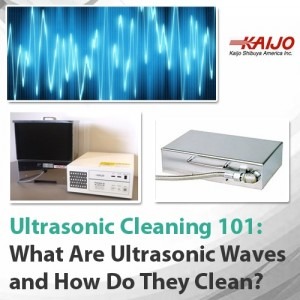Ultrasonic Cleaning 101: What Are Ultrasonic Waves and How Do They Clean?
June 19, 2017
 Ultrasonic cleaning systems use ultrasonic waves to clean parts, tools and equipment quickly and effectively. A typical system is made up of an ultrasonic generator, a transducer and a cleaning tank. The generator produces an electrical signal at the required ultrasonic frequency. Ultrasonic frequencies used range from about 26 kHz to 200 kHz, and a generator may be designed for a single frequency or a frequency range.
Ultrasonic cleaning systems use ultrasonic waves to clean parts, tools and equipment quickly and effectively. A typical system is made up of an ultrasonic generator, a transducer and a cleaning tank. The generator produces an electrical signal at the required ultrasonic frequency. Ultrasonic frequencies used range from about 26 kHz to 200 kHz, and a generator may be designed for a single frequency or a frequency range.
The transducers convert the electric signal to physical vibrations that can create ultrasonic waves in a liquid. The transducer is submerged in the cleaning solution and includes a heavy metal plate. When the transducer receives the electric signal from the generator, the metal plate vibrates at the ultrasonic frequency and fills the liquid in the cleaning tank with ultrasonic waves.
The cleaning tank holds the parts to be cleaned, the cleaning solution and the transducer. It may include a basket to keep the parts from touching the tank walls and bottom, and it may include a heater to warm the liquid. High performance industrial ultrasonic cleaners work with plain cold water but adding a mild detergent and heating the solution can improve cleaning performance for some contaminants.
How Ultrasonic Waves Clean
The ultrasonic waves in the cleaning liquid remove contaminants and dirt from the surfaces of the parts to be cleaned through the action of cavitation bubbles. Just like waves on the surface of a body of water, ultrasonic sound waves have peaks and troughs. When the sound waves travel within a cleaning solution, the peaks and troughs become areas of high and low pressure.
In the low-pressure areas, cavitation bubbles form and the bubbles collapse under high pressure. As an ultrasonic sound wave trough passes the surface of a part to be cleaned, the cavitation bubbles form along the surface. When the high-pressure peak of an ultrasonic wave passes by, the bubbles collapse and release energy which produce a scrubbing action on the surface. This process repeats at the frequency of the ultrasonic wave. As a result, millions of microscopic bubbles form and collapse many thousands of times per second delivering intensive cleaning action by loosening dirt and contaminants and scrubbing the surfaces to be cleaned.
How System Frequency Affects Cleaning Performance
While all industrial ultrasonic cleaners operate the same way, the operating frequency influences what kinds of parts can be cleaned most effectively. In general, low frequencies can better deal with heavy dirt and contamination on hard surfaces while higher frequencies are used for delicate cleaning applications.
The sound wave pressure peaks of low frequencies such as 26 kHz to 38 kHz are relatively far apart, leaving more time for the cavitation bubbles to grow. The comparatively large bubbles give off a lot of energy when they collapse, and the resulting cleaning action is especially intense. Frequencies such as 100 kHz or higher leave less time for the bubbles to grow and the smaller bubbles give off less energy when they collapse. The cleaning action at the higher frequencies is gentler, becoming less aggressive as the frequency rises.
The low frequencies are suitable for items such as metal tools, glass or hard disk drive components. High frequencies are used for more fragile items such as delicate machined parts, semiconductor components or solar cells. Choosing the correct frequency and other ultrasonic system features is critical for optimal cleaning performance.
How Kaijo can Help You Choose the Right System
Global ultrasonic cleaning system manufacturer Kaijo offers a wide range of standard and turnkey solutions and can customize systems to match special cleaning needs. The company has the expertise to evaluate cleaning applications and suggest the ideal system to match specific requirements. Kaijo’s ultrasonic cleaners can clean quickly and completely to help increase manufacturing productivity, reduce the use of harsh cleaning chemicals and improve output quality with better cleaning performance.





